The Atlantic provinces continue to rebuild after post-tropical storm Fiona swept through the region last weekend, toppling trees, washing out roads and causing power outages for hundreds of thousands of people.

The storm, which has been blamed for at least three deaths in eastern Canada, has been described as “historic” by meteorologists and politicians – but Blair Feltmate warns that it won’t be the last powerful storm to cause devastation.
“Fiona reminds us that climate change is real, and we’re going to experience extreme weather going forward,” said Feltmate, head of the Intact Centre on Climate Adaptation.
“We really need to understand that, due to climate change, we’re going to experience more extreme weather in this country, and we need to prepare by way of adaptation, very rapidly, for that extreme weather.”
The Intact Centre on Climate Adaptation is a research centre out of the University of Waterloo that looks at ways governments and homeowners can adapt to the changing climate, which will bring more severe weather events as time goes on.
Feltmate said climate change isn’t some far-off threat: it’s already here, it’s already causing weather events to be stronger and more destructive, and it’s here to stay.
“Climate change is irreversible. Period,” he said. “We are not going backwards on climate change. Extreme weather is going to get more extreme going forward.”

Earlier in the month, Gordon McBean, a professor in the department of geography and environment at Western University, told Global News that climate change won’t necessarily create more hurricanes, but it will increase their intensity.
He said the intensity of a hurricane is driven by the amount of energy it gets from evaporating water from the ocean, which causes it to turn around faster and harder.

Due to climate change, the arctic regions are warming up faster than the tropical ones.
“Canada is warming about twice as fast as the globe … roughly two and a half degrees Celsius (above average),” said McBean, adding that eastern Canada will probably see more severe weather events in the future.
During the 2020 Atlantic hurricane season – one of the most active on record – climate change boosted hourly rainfall rates in hurricane-force storms by eight to 11 per cent, according to an April 2022 study in the journal Nature Communications.
The world has already warmed 1.1 C above the preindustrial average. Scientists at the U.S. National Oceanic and Atmospheric Administration (NOAA) expect that, at 2 C of warming, hurricane wind speeds could increase by up to 10 per cent.

Get daily National news
NOAA also projects the proportion of hurricanes that reach the most intense levels – Category 4 or 5 – could rise by about 10 per cent this century. To date, less than a fifth of storms have reached this intensity since 1851.

Sense of urgency ‘missing’
Feltmate said Canada is doing some aspects of climate change adaptation well, such as developing “very good” guidelines about how to mitigate damage caused by extreme weather events.
However, more work is needed to follow that up with action – and quickly.
“We know what the solutions are. The part that we’re not doing so well is operationalizing solutions – actually putting actions in place, mobilizing actions to mitigate the risk,” he said.
“We still tend to have, in this country, more or less a management-by-disaster strategy. In the aftermath of everything happening, people kick in high gear to bring people back up to working speed, and bring properties back into working action.
“But the far better place to be would be to not have the problems in the first place.”
- Officials stress Calgarians must save water after Bearspaw main break sees no drop in usage
- Snowmobiler dies in avalanche in Rocky Mountains in northeastern B.C.
- Yukon-Alaska border rocked by 3 earthquakes in final hours of 2025
- Pimicikamak chief requests military help as power outage crisis continues
Feltmate said the “tide is turning” when it comes to attitudes toward climate change and mitigation.
Up until about three years ago, most of the conversation about climate change in Canada was about reducing greenhouse gas emissions – which is important, he said, but now the conversation is shifting.
“With floods, fires, extreme heat events, over the last two to three years, the magnitude of extreme weather events are convincing people that, in addition to mitigating emissions, we must also put measures in place to cope with the problems and lessen the impacts, through a large-scale effort on adaptation,” he said.
However, these measures aren’t coming fast enough, said Feltmate.
“What’s missing in Canada is a proper sense of appreciation for the need to act with a great sense of urgency to put adaptation measures in place,” he said. “There still is far too much complacency in the system.”
Coastal houses
According to Feltmate, the biggest risks in Canada from climate change are fires, flooding and extreme heat.
Due to their proximity to the ocean, the Atlantic provinces are certainly at great risk from flooding and erosion, which was demonstrated in this latest storm.
Some of the most striking images from Fiona were coastal houses in Port aux Basques, N.L., being battered by waves and sucked into the sea. Authorities have confirmed a 73-year-old woman died after being swept into the ocean when a storm surge flooded her home.

Feltmate said as extreme weather events are expected to worsen, communities on shorelines need to assess the areas most vulnerable to being hit by water during storms.
In some cases, shorelines can be fortified with higher seawalls and breaker walls. In others, a “strategic retreat” should be considered – moving people away from coastlines altogether.
“There are houses in certain low-lying areas right on the shore that, quite frankly, you can’t do much to protect them, and it may be that the prudent course of action is to move those houses further inland,” he said.
Due to the current cost-of-living and housing crisis, the government would need to step in and help with that, Feltmate said.
He noted that the federal government is working on a national adaptation strategy for climate change, and recommendations are being put forth that the government fund a strategic retreat program, where it would pay for homes to be relocated, or for people to rebuild their homes further inland.
With about 20,000 homes across the country where a strategic retreat could be used, and with an average house price of $640,000, the program would cost around $13 billion.
“So it’s not cheap,” Feltmate acknowledged. “But it’s better than the alternative of simply losing the houses, and then you have to go and rebuild somewhere else anyhow.”
In terms of power outages, cities should invest in more “aggressive” tree-trimming programs to help protect power lines, said Feltmate. This could also be helpful during winter storms when branches and lines get bogged down by ice and snow.
In some cases, burying power lines can be a good idea – but he noted this costs about seven to eight times as much as having power lines above-ground, so it might not always be feasible. However, it could be an option in cases where there’s a new build and the ground is dug up anyway.
Feltmate also said homeowners should have backup generators so they can run sump pumps, especially if they have basements that are prone to flooding.
As well, for new builds or retrofits, hurricane-resistant shingles and hurricane straps – which hold roofs onto houses during high winds – should be considered.
“So there’s an awful lot we can do, that’s very doable, in anticipation in these storms,” he said.
Feltmate also said there’s a “misunderstanding” around adaptation, with some believing these changes are too expensive. But he said with every $1 invested into adaptation measures, there are $3 to $8 in savings from damage that didn’t occur.
“When you’re building new, or you have a scheduled retrofit, it costs more or less the same amount of money to build something right under the umbrella of adaptation, than build it wrong,” he said. “But if you build it wrong and then have to retrofit, it’s very expensive.”
There’s also the human cost of failing to adapt.
For instance, in 2018, the Intact Centre on Climate Adaptation interviewed 100 households in the Burlington, Ont., area, which experienced a lot of precipitation and flooding a few years prior.
Of the respondents that had experienced basement flooding, nearly half reported still feeling very stressed when it rained, even years later.

“It really becomes a way of life. The psychosocial, the mental health stress that people realize, it lasts years and years after the event,” said Feltmate.
“It’s not a matter of weeks, it’s not a matter of months. It’s a matter of years.”
On Wednesday, Federal Infrastructure Minister Dominic LeBlanc told reporters in Ottawa the Liberal government wants to get ahead of “extreme weather events.”
“We totally share the view that if we can get ahead of these extreme weather events now, even though the amounts of money required are significant, it will be much less in the long term,” he said.
“Not only less money in terms of the actual infrastructure adaption and mitigation, but as you’ve heard from my colleagues there are real human and economic costs when some of this infrastructure fails that goes beyond simply the cost of rebuilding.”
During a visit to storm-battered P.E.I. earlier in the week, Prime Minister Justin Trudeau pledged to find ways to build more resilient infrastructure.
“The reality is that extreme weather events are going to get more intense over the coming years because our climate is changing. That’s why we have to make sure we’re adapting to it,” he said.
— with files from Global News’ Aya Al-Hakim and The Canadian Press










Comments